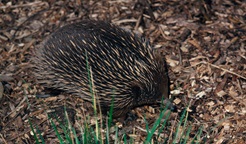Brindingabba National Park
Learn more
Learn more about why this park is special
Brindingabba National Park is a special place. Here are just some of the reasons why:
Protecting Aboriginal culture

Brindingabba National Park is in Budjiti and Kurnu Baakandji Country. Brindingabba is thought to mean 'thunder talks' in Kunja language. Aboriginal heritage items include stone hearths, wells and stone artefacts. We’re working with the local Aboriginal community to protect these important cultural sites.
The Brindingabba scenic drive skirts some sites. Please stay on the tracks to avoid disturbing them.
Home to amazing animals and plants

At least 12 endangered and 31 vulnerable species such as the kultarr, pink cockatoo and brolga are protected at Brindingabba National Park. You can find 96 sorts of birds here including the rare grey-crowned babbler.
The park also conserves mulga shrubland, blackbox and coolibah woodland, and grasslands. It’s the only NSW national park where you can see the endangered lancewood. Yapunyah, a gum tree which produces a delicious honey, also grows here. This tree is found only in outback northern NSW and southern Qld.
- Brindingabba scenic drive Brindingabba scenic drive is a must-do for intrepid 4WD travellers on their way from Bourke to Birdsville. It’s packed with wildlife so bring your binoculars and camera, and find out how many birds an...
Preserving historic heritage

Brindingabba homestead was built in 1893 at the height of the wool boom. It’s a pisé or rammed earth structure. Its materials were harvested from the property’s red soils which can be seen on walls that have not been white-washed. Its wide verandas, tall ceilings and thick walls keep it cool in summer and warm in winter.
The homestead contains historical memorabilia collected by previous owners. Contact the Bourke office to find out when it’s open to visitors.
Nationally important wetlands

Brindingabba National Park lies in the Cuttaburra Basin, connecting 2 major outback rivers, the Paroo and the Warrego. The park protects more than 7,000 hectares of Yantabulla Swamp and part of Lake Wombah, which are nationally important wetlands. The wetlands provide habitat and breeding grounds for internationally protected migratory waterbirds such as freckled ducks, pink-eared ducks, brolgas and night herons.
Plants and animals protected in this park
Animals
-

Emu (Dromaius novaehollandiae)
The largest of Australian birds, the emu stands up to 2m high and is the second largest bird in the world, after the ostrich. Emus live in pairs or family groups. The male emu incubates and rears the young, which will stay with the adult emus for up to 2 years.
-

Red kangaroo (Macropus rufus)
The red kangaroo is one of the most iconic Australian animals and the largest marsupial in the world. Large males have reddish fur and can reach a height of 2m, while females are considerably smaller and have blue-grey fur. Red kangaroos are herbivores and mainly eat grass.
-

Short-beaked echidna (Tachyglossus aculeatus)
One of only 2 egg-laying mammals in the world, the short-beaked echidna is one of the most widespread of Australian native animals. Covered in spines, or quills, they’re equipped with a keen sense of smell and a tube-like snout which they use to break apart termite mounds in search of ants.
-

Wedge-tailed eagle (Aquila audax)
With a wingspan of up to 2.5m, the wedge-tailed eagle is Australia’s largest bird of prey. These Australian animals are found in woodlands across NSW, and have the ability to soar to heights of over 2km. If you’re bird watching, look out for the distinctive diamond-shaped tail of the eagle.
-

Tawny frogmouth (Podargus strigoides)
Found throughout Australia, the tawny frogmouth is often mistaken for an owl due to its wide, powerful beak, large head and nocturnal hunting habits. The ‘oom oom oom’ call of this native bird can be heard echoing throughout a range of habitats including heath, woodlands and urban areas.
Plants
-

Mulga (Acacia aneura)
Mulga are hardy Australian native plants found throughout inland Australia. With an unusually long tap root, the mulga is able to withstand long periods of drought.
-

River red gum (Eucalpytus camaldulensis)
Australian native plants, majestic river red gum trees are widespread across Australian inland river systems. The river red gum is a dominant tree species of the Murray-Darling basin which spans NSW, Queensland and Victoria. This iconic native eucalypt grows to a height of 30m and is thought to have a lifespan up to 500-1000 years.
Look out for...
Short-beaked echidna
Tachyglossus aculeatus

One of only 2 egg-laying mammals in the world, the short-beaked echidna is one of the most widespread of Australian native animals. Covered in spines, or quills, they’re equipped with a keen sense of smell and a tube-like snout which they use to break apart termite mounds in search of ants.
Environments in this park
- Desert and arid shrubland environments
- Wetland environments
- Grassland environments
- Woodland environments
